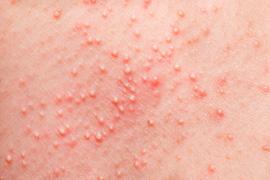Our bodies and minds are deeply connected, and one of the clearest examples of this connection is how stress can show up on your skin. Many people experience stress rashes, a sudden outbreak of itchy, red, or inflamed skin triggered by emotional strain. While stress alone may not cause every skin problem, it often worsens underlying conditions or makes the skin more sensitive to irritants.
What is a Stress Rash?
A stress rash is a skin reaction that appears in response to physical or emotional stress. It typically shows up as raised, red, and itchy patches known as hives (or urticaria). These can appear anywhere on the body most commonly on the face, neck, chest, or arms.
For some people, the rash fades quickly, but in others, it can persist for days or flare up repeatedly during stressful periods.
The Mind-Skin Connection
Stress activates the sympathetic nervous system, triggering the release of hormones like cortisol and adrenaline. While these chemicals help your body handle challenges, they can also cause inflammation, suppress immune function, and disrupt the skin’s barrier.
Here’s how stress affects the skin
-
Inflammation: Stress hormones increase inflammatory responses, leading to redness, itching, and swelling.
-
Weakened immunity: The skin becomes more prone to infections, acne flare-ups, or delayed healing.
-
Barrier dysfunction: Stress can impair the skin’s natural protective barrier, allowing allergens and irritants to penetrate more easily.
-
Worsening chronic conditions: Conditions like eczema, psoriasis, and rosacea often worsen during stressful times.
Common Symptoms of Stress Rashes
Stress rashes can vary, but the most common signs include:
-
Raised, red, itchy welts (hives).
-
Burning or stinging sensation.
-
Dry, flaky patches.
-
Sudden breakouts resembling acne.
-
Spreading irritation when scratching.
They may appear suddenly, last a few hours, or linger for days. If stress continues, the cycle often repeats.
Who is Most at Risk?
Anyone can develop stress rashes, but certain factors increase susceptibility:
-
History of allergies or sensitive skin.
-
Chronic conditions like eczema or psoriasis.
-
Hormonal fluctuations, such as during menstruation or menopause.
-
Immune system disorders that heighten inflammatory responses.
-
High-stress lifestyles with little recovery time.
Managing Stress Rashes Naturally
The good news is that stress rashes are usually temporary and manageable. Here are some strategies:
1. Stress Reduction Techniques
-
Deep breathing exercises lower cortisol levels.
-
Yoga or meditation calm the nervous system.
-
Adequate sleep supports skin repair and immune balance.
-
Regular exercise reduces tension and improves circulation.
2. Skin Soothing Remedies
-
Apply a cool compress to reduce inflammation.
-
Use fragrance-free moisturizers to protect the skin barrier.
-
Avoid scratching, which can worsen irritation.
-
Over-the-counter antihistamines may relieve itching.
3. Healthy Lifestyle Habits
-
Stay hydrated to keep skin elastic.
-
Eat anti-inflammatory foods like fruits, vegetables, and omega-3-rich fish.
-
Limit caffeine and alcohol, which can dehydrate skin and increase anxiety.
When Medical Treatment Is Needed
While many stress rashes fade with self-care, there are situations where professional treatment is important:
-
Rashes that spread quickly or last more than a week.
-
Painful, blistering, or oozing patches.
-
Difficulty breathing or swelling of the lips, tongue, or throat (a medical emergency).
-
Recurrent flare-ups interfering with daily life.
A healthcare provider can recommend prescription creams, stronger antihistamines, or even short-term corticosteroids.
The Role of Cephalexin Capsules
Sometimes, stress rashes may become complicated by secondary bacterial infections especially if scratching damages the skin. In such cases, a doctor may prescribe cephalexin capsules, an antibiotic commonly used to treat skin infections caused by bacteria like Staphylococcus aureus or Streptococcus.
It’s important to note
-
Cephalexin does not treat the rash itself or the stress behind it.
-
It is only effective against bacterial infections, not viral or allergic rashes.
-
Always take cephalexin capsules exactly as prescribed, completing the full course to prevent antibiotic resistance.
By reducing infection risk, cephalexin helps the skin heal while you continue managing the underlying stress that triggered the rash.
Preventing Future Stress Rashes
Since stress is a recurring part of life, prevention strategies focus on resilience
-
Identify stress triggers work overload, lack of rest, emotional strain.
-
Practice time management to avoid feeling overwhelmed.
-
Engage in hobbies or relaxing activities that give your mind a break.
-
Seek support from friends, family, or a counselor when stress becomes unmanageable.
-
Protect your skin with gentle, hypoallergenic products to reduce irritation risk.
Final Thoughts
Stress rashes are a visible reminder of how closely the mind and body are linked. They highlight that taking care of your emotional well-being is just as important as skincare routines.
While most rashes clear with simple remedies and stress management, persistent or infected rashes may require medical care. In some cases, antibiotics like cephalexin capsules are prescribed to control bacterial infections, ensuring your skin recovers fully.
By addressing both stress and skin health together, you can break the cycle of irritation and build a healthier, more resilient body.

